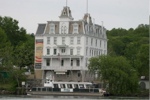GAY CITY STATE PARK
Gay City State Park offers a glimpse into Connecticut's industrial roots with over 1500 acres of endless opportunities for outdoor fun including the exploration of extinct mill-town ruins and stone foundations.
Geology
Gay City State Park is known for its lakeside beaches, however, the park reveals a significant amount of Connecticut geology as well. As you enter the park from Route 85, follow the park road and bear to the left where the road forks. At the end of the road is a small parking lot with an entrance to the white trail leading to the Mill Site.
The first large structure on the white trail is an old mill site. The foundation of the mill can still be seen, as well as the chute that leads to the small stream that flows by. The foundation of the mill is predominantly built from gneiss, a high-grade metamorphic rock subjected to intense heat and pressure during formation. Gneiss is easily identifiable by the segregation of light and dark minerals giving it a banded texture.
At the mill site, the stream on your right has a high iron concentration in the water. As a result of this high iron concentration, the water has a red tinge. Upon crossing the stream, the blue trail begins, marked by a gneiss boulder in the middle of the trail. At the pond, a new rock type is exposed. Amphibolite, a metamorphic rock that forms under intense heat, pressure, and by the action of hot fluids, is exposed as boulders near the pond. Originally, amphibolite was probably either basalt or shaly limestone, before metamorphism. The dark mineral present in amphibolite is amphibole, an elongate black splintery mineral. Some of the amphibolite boulders have pegmatite veins. Pegmatite is an igneous rock that formed from molten rock buried deep below the surface of the Earth. Since the molten rock was well insulated beneath the surface, it cooled very slowly, allowing the crystals to grow very large. In fact, pegmatite crystals can reach lengths of up to 12 m. Generally small, pegmatite intrusions usually have the same composition as granite, only coarser. Furthermore, pegmatite intrusions are of great interest to mineral collectors because they may contain a variety of rare minerals. This pegmatite contains quartz, biotite, muscovite, and feldspar.
After observing the amphibolite, you will begin hiking on the red trail. Along the red trail there are several outcrops and boulders of gneiss. Most interestingly, a large gneiss outcrop is on the right hand side of the trail, which has parallel fractures. The fractures produce clean breaks that give the rocks a boxlike shape.
Continuing down the trail you will see an outcrop of schist protruding onto the trail. The schist is part of the Collins Hill Formation. Schist is a type of metamorphic rock that has undergone intense heat, pressure, and hot fluids. By definition, schist contains more than 50% platy and elongate minerals such as mica and amphibole. This high percentage of platy minerals allows schist to be easily split into thin flakes or slabs. This schist is rusty and contains biotite, muscovite, garnet, and can easily be broken.
As you make your way back onto the white trail you will encounter more gneiss right before a large pond. There is a man made waterfall and beach along the pond. The sand has been brought into the park and is mostly quartz and feldspar. The parking lot near the beach is lined with large boulders, most likely brought in from the Glastonbury Gneiss Formation, which is not exposed in this park.
The other trails lead you through swampy areas on the outskirts of the park. There are very few exposed outcrops or boulders along these trails. The trails will lead you through a densely wooded area and across many small streams.
Located on the Hebron-Bolton town line, Gay City's 1,569 acres of parkland offer swimming, picnicking and an almost endless opportunity for exploration. The name "Gay City" derives from a now-extinct mill town that once occupied the site. Today only some tumbling stone foundations, several grass-filled cellar holes and a few silent tombstones suggest its former existence.Gay City was first settled in 1796 by a religious sect led by Elijah Andrus and later by Rev. Henry P. Sumner. The Gays soon comprised the majority of the 25 or more families who then lived in the community. The residents kept strictly to themselves, existing as distinctly separate from the neighboring communities. They built a sawmill along the Black Ledge River and erected homes from the lumber.
Gay City's fate changed with the successes and failures of several commercial enterprises. A woolen mill on the site 1/4 mile below the present pond was a successful business until extreme pressures caused by the various blockades during the War of 1812 brought its closing. Once revived, the mill burned to the ground in 1830, beginning the town's decline with the exodus of many people to urban factory jobs. Rev. Sumner's son built a paper mill which again revived the town somewhat until the Civil War, when many of the town's younger men were killed in battle. Soon after, the mill burned down, triggering the final demise of Gay City and nature's reclaiming of the land.
Connecticut has made state parks, forests, trails, historic sites and beaches more accessible to our residents so they can enjoy the many attractions and beauty they offer. Under the Passport to the Parks program, parking fees are now eliminated at Connecticut State Parks for those with Connecticut registered vehicles. You can view the
CONNECTICUT PASSPORT TO THE PARKS web page to learn more.
Youth Group Camping areas are available to qualifying youth organizations. The group camp areas are generally away from main public use areas, giving group leaders maximum control over their group's camping experience. This program is designed to encourage youths to learn about nature and the camping experience.



